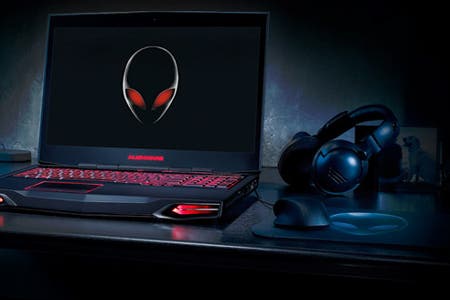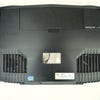Radeon HD 7970M Review
The world's most powerful mobile graphics card put to the test in the new Alienware M17x refresh - and what it means for next-gen consoles.
While NVIDIA's new Kepler architecture takes possession of the performance crown in the desktop arena, the outlook is somewhat different in laptop territory. Here, AMD currently rules supreme with its Radeon HD 7970M mobile graphics core - a piece of technology important for a number of reasons. Firstly, it's powerful enough to handle some of the most advanced DirectX 11 titles at high frame-rates and extreme resolutions. Secondly, the size of the silicon and the power it requires potentially makes the 7970M a viable contender for a next-gen console graphics solution.
First up, let's talk about the laptop hosting this formidable kit. Supplied by Alienware, the new R4 revision of the M17x features a chassis that is superficially identical to the one used for the R3 model we reviewed a couple of months ago. It's a solid foundation which evidently didn't need much tweaking in terms of finish; the backlit keyboard, 17-inch LCD, and wide spread of connections (including optical out from a new Sound Blaster Recon3Di sound card) embed cleanly into a sturdy, rubberised matte exterior, with glossy flourishes for the two front speakers and its palm rest. For a laptop set in this higher price bracket, it looks the part in its own stylised way, and is reassuringly resilient to downward pressure during gameplay.
But, of course, it's under the bonnet that we see the more radical changes. To begin with, the existing 32nm Sandy Bridge Intel CPU has been ousted in favour of an 22nm Ivy Bridge equivalent, offering a small but useful bump in performance, improved battery life (particularly at full load, not so much at idle) and a far superior Intel HD4000 integrated GPU. This stands in as an energy-efficient graphics output for general use, such as web browsing or watching video, though the Switchable Graphics controls ensure you won't be using it for actual gaming so long as the 7970M is active.
There's also support for 1600MHz DDR3 RAM configurations as standard, plus the adoption of mSATA-based SSDs - small, but ultra-fast drives starting at 32GB. These are designed to work in tandem with cheaper, more capacious HDDs, intelligently caching your most regularly accessed data based on usage patterns. In theory, the longer you use the laptop, the more efficient it becomes, with the ultimate aim being to deliver comparable performance to larger 500GB SSDs, albeit at a far lower price point.
The final major addition to the Alienware R4 is support for the new 28nm range of graphics cores from both NVIDIA and AMD. We asked Alienware for the best available GPU for our review machine and, in the 7970M, that has been delivered. What makes this graphics processor a stand-out from the crowd is the fact that it's running on the exact same "Pitcairn" architecture that powers the best desktop GPU in the sub-£300 sector - specifically, the impressive Radeon HD 7870.
In fact, in almost all aspects the 7970M is the match of the full desktop version: there are 20 compute units offering 1280 stream processors in all, 80 texture units, 32 ROPs and 2GB of dedicated GDDR5 RAM. Indeed, the only difference amounts to the speed of the GPU - the 7870 operates at 1GHz while the mobile version is downclocked to a "mere" 850MHz. However, memory clockspeed and bandwidth are identical at 1.2GHz, or 4.4GHz effective.
Radeon HD 7970M: Performance Analysis
"The best mobile GPUs always fall short of the best that desktop graphics cards can offer, but the 7970M produces some excellent results, boding well for graphically rich action."
In terms of performance, tests elsewhere have placed the 7970M somewhere between the £200 7850 and the pricier 7870. That's a serious amount of power for a mobile solution, so let's begin our analysis by running the Alienware review kit through a battery of benchmarks and comparing them with our recent high-end desktop GPU tests.
On the one hand, some may be quick to point out the unfairness of the comparison - it's hardly apples for apples after all. To expect a mobile GPU to compete with a top-end desktop solution is hopeful at best and, as if the the odds aren't sufficiently stacked against it already, our test desktop set-up also features a 3.3GHz quad core Nehalem CPU to its benefit. By contrast, the Ivy Bridge chip in this notebook is essentially a generation ahead, but a 1GHz shortfall in clockspeed is certainly a big difference to make up.
On the other hand, it's a parallel worth bearing out for posterity. If not to carry a top-end desktop experience in a mobile package, then what is it that we're looking for in a high-spec, premium-priced gaming laptop of this nature? Based as it is on an existing, well-reviewed desktop graphics core, chances are you'll be pleasantly surprised at just how close this mobile GPU gets to the current market leader in the desktop space. The gulf in performance is perhaps not as extreme as you would at first imagine, and it's impressive that it can stand tall as a bona-fide contender.
First up, here's the perennial favourite benchmark: 3DMark11 - running at both the 720p performance and 1080p extreme settings.
Futuremark 3DMark 11: Tested on standard Performance and Extreme settings.
| Radeon HD 7970M (Performance) | Radeon HD 7970M (Extreme) | |
|---|---|---|
| Graphics Score | 5556 | 1636 |
| Physics Score | 7537 | 7523 |
| Combined Score | 5527 | 1978 |
| 3DMark 11 Score | P5780 | X1808 |
This makes for some enlightening results, especially when placed side-by-side with the desktop GTX 580, GTX 670 and GTX 680 scores we published recently. Based on the performance tests, the current best desktop GPU on the market offers a 50 per cent increase in terms of the graphics score, but in terms of the physics score, the 7970M actually beats the GTX 680. Meanwhile, up against the GTX 580 (a card that still commands a £300 premium) the gulf in graphics performance drops to just 12 per cent, and the physics score of the 7970M is about 15 per cent ahead - a clear testament to AMD's tendency to lead in compute performance.
Next up, a look at Metro 2033's built-in Frontline benchmark shows us how the card reacts to heavy high-resolution texture work and a barrage of explosion effects. While we find this test generally makes for similar performance on all of the high-end NVIDIA GPUs we've run it on as of late, this doesn't prove to be the case with the Radeon HD 7970M. Here, we see results come in at around 20 per cent lower - still a remarkable achievement.
Metro 2033 Frontline Benchmark: DX11, 1920x1080, very high quality, 4x MSAA, AF 4x anisotropy, advanced PhysX enabled, tessellation Enabled, depth-of-field enabled.
"Benchmark testing throws up some superb results - this is high-end GPU performance being extracted from a mobile graphics core that uses only 65 watts of power."
| Radeon HD 7970M | |
|---|---|
| Min FPS | 5.62 |
| Max FPS | 44.08 |
| Average FPS | 22.39 |
Lastly, we round off the raw benchmark tests with Batman: Arkham City's built-in performance analysis, which runs us through several major areas from the game - from areas filled with gnarled, botanical flourishes to a heavily-lit fortification filled with guards. Obviously PhysX is not an option here, but even in its absence the test is an exhaustive run-through of Unreal Engine 3's latest features, including DX11 effects such as tessellation. Here a gap does open up with the high-end desktop parts we've looked at in the past (around 35 per cent), but overall performance is once again highly creditable on the 7970M. By lowering the global settings to High, we find that achieving a relatively level 1080p60 output is well within reach for actual gameplay.
Batman: Arkham City Benchmark: DX11, 1920x1080, 8x MSAA, high tessellation, very high detail, all other settings enabled.
| Radeon HD 7970M | |
|---|---|
| Min FPS | 5 |
| Max FPS | 45 |
| Average FPS | 31 |
Radeon HD 7970M: Gameplay Analysis
Moving away from the customary hoop-jumping of benchmarks, then, we put the graphics processor to practical use by playing two of the most technologically taxing games going on the PC market: DICE's Battlefield 3 and Crytek's Crysis 2. These happen to be two stalwart performers in our previous GPU tests, though our testing criteria shifts somewhat in this case. Rather than rushing straight to maximum settings for each, we're instead inclined to keep performance as close to 60 frames per second as possible while still squeezing out as many of each title's visual features.
What we haven't changed is our preference for running at a resolution of 1920x1080; our sample Alienware M17x is equipped with a full HD display that makes this a good, native fit. For the sake of consistency with our other tests, we're also steadfast in our determination to keep v-sync engaged in order to maintain image consistency, and to keep gameplay hinged to the screen's 60Hz refresh. This is an attitude we may revisit should adaptive v-sync, a console trick which allows sync to disengage at the risk of dropping below 60FPS, ever become a standard across both AMD and NVIDIA GPU lines.
Let's take a look at DICE's Battlefield 3 first, a game that is fully optimised for DX11 and with support for the multiple threads available in this laptop's i7 CPU. In terms of performance, your mileage may vary depending on which portion of the Battlefield experience you're most eager to put time into. We tested the Operation Swordbreaker campaign stage to get a sample of an extreme in single-player, where stepping out of the vehicle with your squad drags both high and ultra presets down to the 50 and 45FPS marks, respectively. The demands of higher-precision shadowing, HBAO and multiple NPCs takes its toll here, where maintaining a uniform 60FPS refresh only becomes possible on dropping to Medium.
Both of our performance analysis videos on this page are encoded at 60 frames per second - use the full-screen mode to boost performance or else check out this review on an iPad or similarly hardware accelerated device.
"Dialling back some of the settings, the 7970M is capable of playing Battlefield 3 at a sustained 1080p60. In multiplayer, graphics quality tweakables can be comfortably left at high settings."
Here we see the game running at an optimal frame-rate on medium settings, while on the right we stretch for the next rung up on the graphical ladder with high. As an indicator of what's possible on the multiplayer side, this is promising. Even with 64 players running around larger maps such as the Caspian Border, we find sustaining a competition-worthy level of performance on high settings is entirely feasible, with far fewer drops than in single-player. Alas, while traditional MSAA isn't a staple on this preset, a high quality FXAA option does a respectable job all on its own, and sidesteps the performance hits associated with multi-sampling a full 1080p image.
With DICE's latest shooter pushing out some astounding visuals at a fair clip on the 7970M, we turn to Crytek's flagship first-person shooter with high expectations. Overall, we find Crysis 2 is much better optimised for current platforms than its predecessor, and for our tests we've decided to run the game patched up to v1.9, with both the DX11 and high resolution texture pack add-ons installed and enabled.
Once again, hitting full marks on the FPS scale is not possible at maximum settings, dubbed ultra in this case. Instead, in testing out the early submarine crash sequence, followed by a trail around New York test centres, we find making a mix 'n' match preset is the best way to go. By keeping all settings at ultra, but dropping post-processing, shading and water options down to very high, we can hit a perceptual 60FPS (accepting occasional dips to 55) while keeping as much of its visual fidelity intact. The blanket solution is, of course, to just toggle the whole lot down to very high - something we test in the following video.
"Crysis 2 at a smooth 1080p60 with the high-res texture pack and DX11 features engaged proves to be no problem at all so long as the settings are set to the very high level."
By comparison to extreme, this lower preset seems to be very well suited to the M17x's capabilities. The next rung up simply proves too strenuous when pumping out the higher-detailed enemy models that fill out battle scenarios, with the higher-quality post-processing being culpable for some lofty demands as well. The loss of motion blur on Very High is also conspicuous in these side-by-side comparisons, and dropping DX11 does little to help elevate extreme performance from this level. Nevertheless, it's a good showing overall, particularly given that it can be custom-tailored to a mixture of settings, up to and including elements of ultra.
But what of other games? While these Crysis 2 and Battlefield 3 currently represent the deep end of the gaming pool, it must be said that the 7970M is a faultless performer in almost every other recent release. Looking at Elder Scrolls V: Skyrim, we quickly establish that having everything entirely maxed out is possible with no real penalty - just an occasional stutter when approach Whiterun castle from a distance as geometry pops in. Similarly, we have no trohubles playing 4v4 multiplayer games of StarCraft 2 at anything less than extreme settings, which gives us a healthy overhead for those crucial 1v1 face-offs.
Alienware M17x R4/Radeon HD 7970M: The Digital Foundry Verdict
In our review of the R3 version of the M17x, we came away impressed with the NVIDIA 3D Vision capabilities of the unit, but even with two GTX 460Ms running in SLI there was a sense that the unit couldn't quite deliver a top-end desktop-style experience while on the go. While this AMD-equipped review unit lacked the 120Hz LCD we had on our previous M17x (topping out at the conventional 60Hz) we found that the overall gameplay experience on the most challenging games with demanding settings was significantly improved.
"If you're looking for the absolute best in graphics power from your next laptop, and you have significant amounts of cash to spare, a 7970M-based laptop like the M17x is the machine to buy."
Inevitably, we do need to dial down settings in Crysis 2 and Battlefield 3 to uphold smoother response, but it's fair to say that generally speaking, a law of diminishing returns applies to GPU quality settings when you're moving between High and Ultra-level settings. The overall impression remains breathtaking, and the mere fact that we could get so much performance with so many effects in play speaks very highly of the 28nm Pitcairn architecture that has been crowbarred into this mobile chassis, and points to a potentially bright future for the next-generation consoles.
But why might the 7970M's design have a bearing on the upcoming generation? Simply put, the power efficiency of the graphics core in tandem with its discrete physical size, form two crucial factors that are sure to attract the attention of both Microsoft and Sony's R&D departments. And if the rumours are true, both have tasked AMD with designing the graphics chips for their next consoles, making the capabilities of the 7970M even more intriguing.
The Pitcairn core is fairly small, occupying 212mm2 of area. Compare that with the 240mm2 of the RSX in the launch version of the PlayStation 3 and the 180mm2 of the Xbox 360's original 90nm Xenos GPU and we have a ballpark match. Of more interest is power consumption: at full tilt, the 7970M sucks up around 65 watts of power. That's not going to be especially good news for a laptop running on battery power alone, but considering that the launch versions of the Xbox 360 and PS3 both consumed around 200W in total, again we see an eminently suitable match.
But times have moved on from 2005 - Microsoft won't need to invest so much in gaining market share next time around, while Sony simply can't afford to lose hundreds of dollars per unit as it did with PlayStation 3 back in the day. While a Pitcairn core is viable for a next-gen console, the fact remains that it's an expensive, high-end piece of kit and there's no guarantee that the raw power of this remarkable GPU will end up in the new console designs. But if it were, we can reasonably expect next-gen games to outperform what we have shown in this article - the advantages of a fixed architecture in a console mean that developers target the specific strengths of the GPU, inevitably producing results that punch above their weight compared to the same hardware running on PC.
The fact that this level of performance can now be enjoyed in a mobile form factor in the here and now is big news - if you're looking for the absolute best in graphics power from your next laptop, and you have significant amounts of cash to spare, a 7970M-based laptop like the M17x is the machine to buy. Or if you want to really push the boat out and have two grand to drop on a games machine, an M18x with two 7970Ms in CrossFire (!) should be the final word in mobile GPU performance. At least, for now.
















